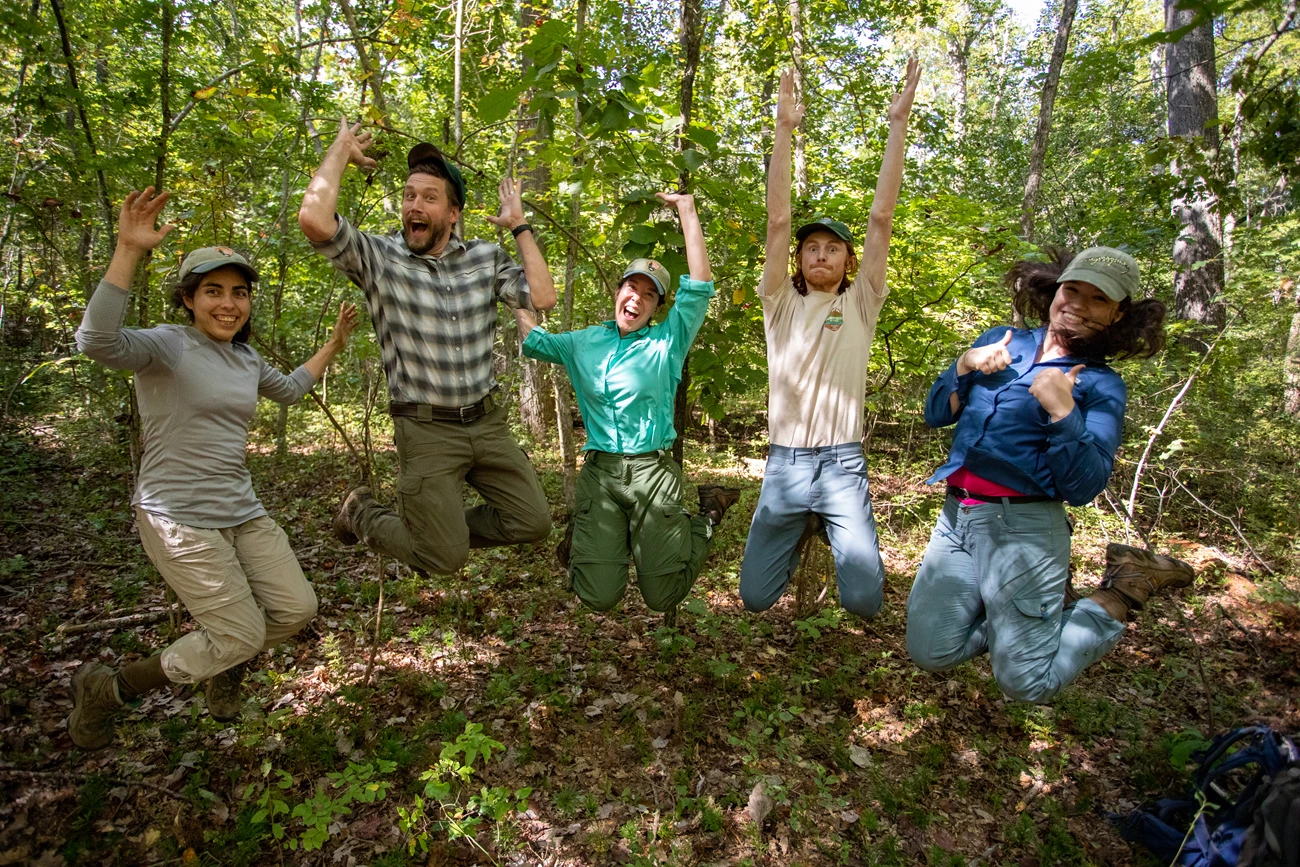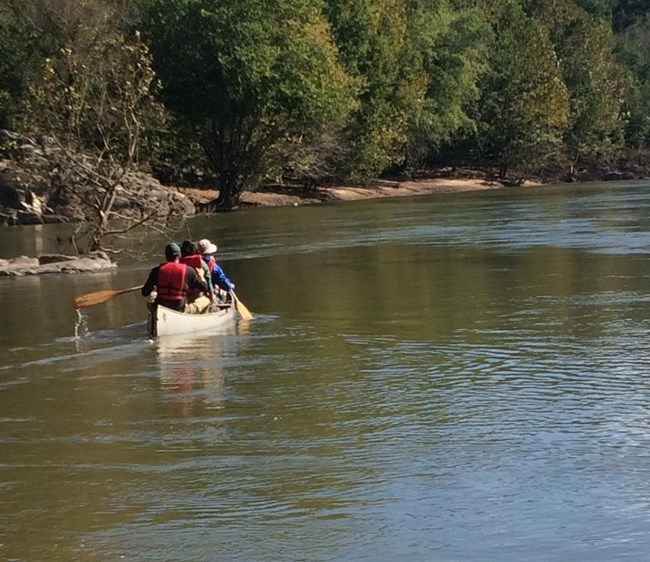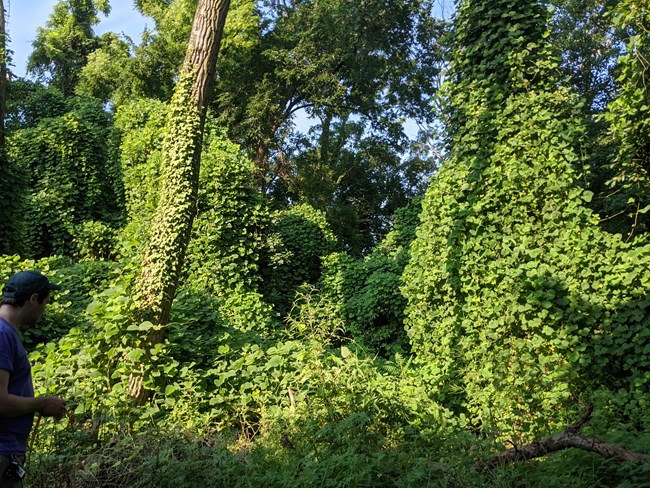Last updated: April 26, 2023
Article
A Forest Monitoring Cycle Like No Other
By Nicholas Tait, NCRN I&M Science Communication Intern

NPS / Claire Hassler
The National Capital Region Inventory & Monitoring Network (NCRN I&M) forest monitoring crew has completed its fourth cycle of forest vegetation monitoring, sampling over 400 plots across the 11 parks of our region. Unlike the ones before it, this cycle took five years instead of four due to COVID-19 delays. Despite the setback, the I&M forest team persevered, collecting quality forest vegetation data to aid parks in making informed management decisions.
Long term monitoring requires the hard work and collaboration of many people. I&M has been monitoring forest health in NCR parks since 2006 and the effort relies on park managers, biologists, seasonal biological technicians (bio techs), summer interns, and volunteers. Together, we experience the beauty and the beast of our parks, traveling to the thorniest thickets and the most scenic overlooks to keep tabs on key forest indicators. Continue reading for an inside peek into life on a forest crew these past five years.
Starting Strong
2018. The fourth cycle of forest monitoring kicked off with an unforgettable first season. I&M biologist Andrejs Brolis called it the “year of unique plots.” Most notable for him was the plot on a Monocacy River sandbar, covered in scraggly, multi-stemmed sycamore trees which constantly expelled fuzz into the air. “Whether you have allergies or not,” Brolis said, “the sycamore fuzz is highly allergenic. The moment any of that stuff gets into your system your nose starts running, you start sneezing and coughing, your eyes are watering, and it keeps on getting worse and worse.”

NPS / Brolis
But it would get better as the season went on. Due to heavy rainfall, access to plots on Sherwin Island in the Potomac River and in Harper’s Ferry off the Shenandoah River required paddling canoes over rushing rapids. “It’s fun because it’s a totally unique experience,” Brolis recalled with a laugh. “We don’t usually get to take a boat out to any of our plots.”
2019. I joined the forest crew as a biological technician and spent memorable days slogging through the mud of Piscataway Park, racing against summer storms in western Maryland, and lint-rolling off ticks by the nest-full from my pantlegs. Our crews overcame the “usual” challenges of a field season. In two years, we’d visited 214 forest monitoring sites and assessed the health of over 130 species.
A Forest Crew without a Forest
2020. I began my second season with the I&M forest crew in March, returning to work early with the Invasive Plant Management Team. We filled our backpack sprayers, loaded the trucks, and braved the late winter cold of Rock Creek to treat lesser celandine and promote the emergence of native ephemerals come spring. Three weeks later, we were stuck at home during the first COVID-19 lockdown.
So, what does a forest crew do without a forest? As it turns out, a ton of data management and constant daydreaming about oak-hickory canopies.
Fortunately, after several safety meetings and adjustments to field methods, we managed to get ourselves back in the woods. New procedures limited us to one employee per vehicle, so we arrived at parks in a fleet of cars. We wore masks in the summer heat, operated with fewer than usual seasonal staff, and accepted that, for the first time since 2006, we wouldn’t be able to complete the full slate of plots for the year.
We still successfully sampled 35 of the planned 114 plots, monitoring in Catoctin Mountain Park, Monocacy National Battlefield, and Rock Creek Park—the three NCR parks with the longest history of deer management.

NPS / Fishtahler
2021. The forest crew returned to tackle the remaining 79 plots of Panel 3. Bolstered by new and returning staff, the team trudged through the inundated plots of Dyke Marsh, battled kudzu vine jungles in National Capital Parks-East (NACE), and, despite lingering pandemic challenges, put I&M back on track to finish another monitoring cycle. Lead bio tech Lindsay Ashley started in 2021 and “one day at a Prince William plot,” she said, “the crew had a discussion about being friends outside of work too. It's fun when coworkers can be built in friends!” She also remembers, less fondly, getting a case of heat exhaustion at a kudzu-infested plot in NACE.
Return to “Normal” Operations
2022. The fifth and final field season saw a return to normalcy with a full field crew and some new interns to boot. One of these interns, Galen Oettel, reflected on that first year working with NCR parks. “It was a fun field season,” he said. “A highlight was definitely seeing an eagle fly overhead at a plot in NACE. A lowlight was getting poison ivy rash all over my arms…at that same plot.” The forest crew sampled the over one hundred plots planned for the season to close out the fourth forest vegetation monitoring cycle.
So Much Data!
Our efforts these past five years have resulted in an abundance of data. The table below shows some of these data by the numbers—exactly how many trees, seedlings, saplings, and other forest features we measured and identified during the fourth cycle of monitoring, along with some of the most common species we encountered. The data we collected, combined with the 12 years-worth of data gathered since 2006, give us a clearer picture of what changes have occurred in NCR forests and hopefully offer a glimpse into their future.
Table 1: Some of the forest vegetation data collected during the fourth cycle of monitoring.
| Forest Plant Type | Number of Individuals Sampled | Number of Species Sampled | Most Common Species |
| Living Trees | 11,526 | 95 Trees (+ saplings and tree seedlings) | American Beech (Fagus grandifolia) |
| Saplings | 3,000 | n/a | Pawpaw (Asimina triloba) |
| Tree Seedlings | 3,970 | n/a | Pawpaw (Asimina triloba) |
| Shrubs | 690 | 45 Shrubs (+ shrub seedlings) | Bush honeysuckle (Lonicera mackii) |
| Shrub Seedlings | 2,611 | n/a | Spicebush (Lindera benzoin) |
| Vines on Trees | 4,870 | 30 vines | Frost grape (Vitis vulpina) |
| Forest Floor species (mostly invasive - not a complete list of everything in the plots) | 10,198 | n/a | Japanese stiltgrass (Microstegium vimineum) *most widespread invasive cover |
What’s Next?
I&M staff are now analyzing forest data to assess the state of NCR park forests. Be sure to check our forest monitoring webpage for future articles on forest regeneration, non-native pests and diseases like emerald ash borer and beech leaf disease, and other findings from this past cycle of forest vegetation monitoring.
And what’s next now that we have amassed nearly two decades of monitoring data? More monitoring! I&M will continue to gather information on forest vegetation in the National Capital Region to help parks manage these natural resources for years to come.
Tags
- antietam national battlefield
- catoctin mountain park
- chesapeake & ohio canal national historical park
- george washington memorial parkway
- harpers ferry national historical park
- manassas national battlefield park
- monocacy national battlefield
- national capital parks-east
- prince william forest park
- rock creek park
- wolf trap national park for the performing arts
- ncrn
- ncrn im
- i&m
- trees
- seedlings
- saplings
- shrubs
- vines
- forest
- eastern deciduous forest
- forest monitoring
- field work
- natural resource quarterly
- spring 2023
